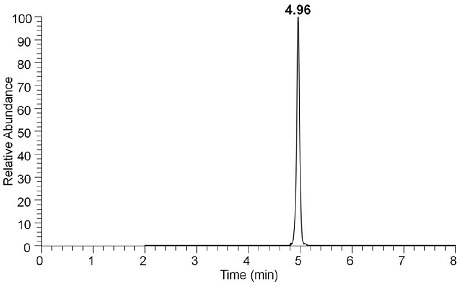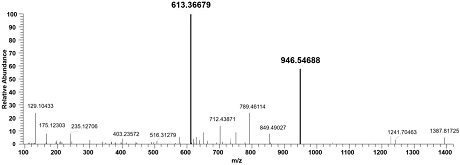A liquid chromatography-tandem mass spectrometry-based method for the detection of Apis mellifera mrjp1 and its application in the identification of Apis mellifera honey
A technology of tandem mass spectrometry and liquid chromatography, which is applied in the field of food testing, can solve the problems that the research on the authenticity of bee honey is still blank, and achieve the effect of maintaining the ecological diversity of bee genes, good accuracy and precision, and high sensitivity
- Summary
- Abstract
- Description
- Claims
- Application Information
AI Technical Summary
Problems solved by technology
Method used
Image
Examples
Embodiment 1
[0036] Example 1 Discovery of specific peptides of Apis mellifera MRJP1
[0037] 1. According to the mass ratio of 1:1, weigh the small
[0038] Bee honey and PBS solution, vortex fully, centrifuge at 4°C for 20 min, and collect the supernatant;
[0039] 2. Take 50 μL supernatant and add 200 μL 40 mM NH 4 HCO 3 The solution was vortexed and mixed with it, and 25 μL of 100 mM DTT solution was added. After fully vortexed and mixed, the reaction was carried out at room temperature for 60 minutes, and then 125 μL of 100 mM IAA solution was added for 60 minutes of dark reaction at room temperature;
[0040] 3. Add 2 μg excess trypsin to the final solution in step 3, and digest overnight at 37°C. Add 1 μL of formic acid solution to terminate the digestion reaction. After the digestion product was mixed with 0.1% formic acid solution at a volume ratio of 2:3, it was desalted through a C18 column, and the desalted sample was vacuum-dried.
[0041] 4. Detection of peptides: The sa...
Embodiment 2
[0044] Example 2 Establishment of characteristic peptides of Apis mellifera MRJP1 and development of detection methods
[0045] All the specific peptides screened out in Example 1 were verified on the NCBI and Uniprot websites, and the specific peptides that only existed in the MRJP1 of the small bee were screened to obtain multiple specific peptides of the MRJP1 of the small bee. The sequences are as follows:
[0046] 1) IKEALPHVPILDR (SEQ ID No. 1)
[0047] 2) FFDYDFGNDER (SEQ ID No. 2)
[0048] 3) LTSNTFNYDPEYTK (SEQ ID No. 3)
[0049] 4) YNGVPSSLNVISNK (SEQ ID No. 4)
[0050] 5) NNYPSDIDQWHGK (SEQ ID No. 5)
[0051] 6) TVAQNNETLQMIVGMK (SEQ ID No. 6)
[0052] 7) QVQIPHDIAVNTTTGK (SEQ ID No. 7)
[0053] Although there are many specific peptides to choose from, considering factors such as the uniqueness, stability, and ion response of the peptides on the mass spectrometer, only one of the optimal characteristic peptides can be selected for quantitative analysis. Looki...
Embodiment 3
[0067] Example 3 The practical application of the method for detecting the characteristic peptides of Apis MRJP1
[0068]1. Buy honey made by Italian bees (acacia honey, linden honey and wattle honey), soil honey (honey made by Apis cerana), honey made by big bees (tree honey) and honey made by small bees from regular markets. Honey and other samples are tested on actual samples.
[0069] 2. Detection of samples of honey brewed by 8 different species of bees
[0070] (1) Weigh the same amount of different honeys into centrifuge tubes, add PBS solution at a ratio of 1:1, vortex fully, centrifuge at 4°C for 20 min, and collect the supernatant;
[0071] (2) Take 100 μL supernatant and add 400 μL 40 mM NH 4 HCO 3 The solution was vortexed and mixed with it, and 50 μL of 100 mM DTT solution was added. After fully vortexed and mixed, it was reacted at room temperature for 60 min, and then 250 μL of 100 mM IAA solution was added to react in the dark at room temperature for 60 min;...
PUM
 Login to View More
Login to View More Abstract
Description
Claims
Application Information
 Login to View More
Login to View More - R&D
- Intellectual Property
- Life Sciences
- Materials
- Tech Scout
- Unparalleled Data Quality
- Higher Quality Content
- 60% Fewer Hallucinations
Browse by: Latest US Patents, China's latest patents, Technical Efficacy Thesaurus, Application Domain, Technology Topic, Popular Technical Reports.
© 2025 PatSnap. All rights reserved.Legal|Privacy policy|Modern Slavery Act Transparency Statement|Sitemap|About US| Contact US: help@patsnap.com



